Did you ever notice that little extra chamfer between the lugs of vintage Datejust and Day-Date models? Did you also notice that you won't find this on steel versions of the same references? I can only wonder, why? ... Background knowledge and deep discussions on the big pictures of the vintage watch world is what you typically come here for... But at times it's the little details that grab my attention for much much longer and make me wonder.
April 24, 2024
Why Gold and Steel Rolex Oyster Cases Are Shaped Differently

Marcus Siems @siemswatches
Collector, Author, Data Analyst
Background knowledge and deep discussions on the big pictures of the vintage watch world is what you typically come here for... But at times it's the little details that grab my attention for much much longer and make me wonder.
For example: Did you ever notice that the Rolex Oyster cases in gold are shaped differently than their steel counterparts? And I'm speaking of gold versus steel within the same reference from the same year! What may sound cryptic now will become evident once you've seen it:
 Comparing vintage Rolex Datejusts in gold (left) and steel (right). Take a close look at the lugs and how these are integrated into the case. Photos from Goldammer Archives.
Comparing vintage Rolex Datejusts in gold (left) and steel (right). Take a close look at the lugs and how these are integrated into the case. Photos from Goldammer Archives.
Take a closer look at the lugs and particularly how they are integrated into the case structure. While on the steel case the lugs transition straight into the Oyster case, on gold cases there is an additional chamfer+ between the case outline and the lugs. A bit of a surface area that you will find only on golden cases. It is a detail that effectively straightens the upper/lower flank of the case visually but what other purpose may it serve?
1) The Timeline
The interesting bit is that not all models or collections came with this feature. You will find this only on Datejust and Day-Date references. From the first Datejust reference onwards - the ref. 4467 - this is evident and it lasts until the modern Datejust II in 41mm was introduced in 2009! That's a pretty long time, for 64 years there existed a steel/gold dichotomy of Datejust/Day-Date case designs.
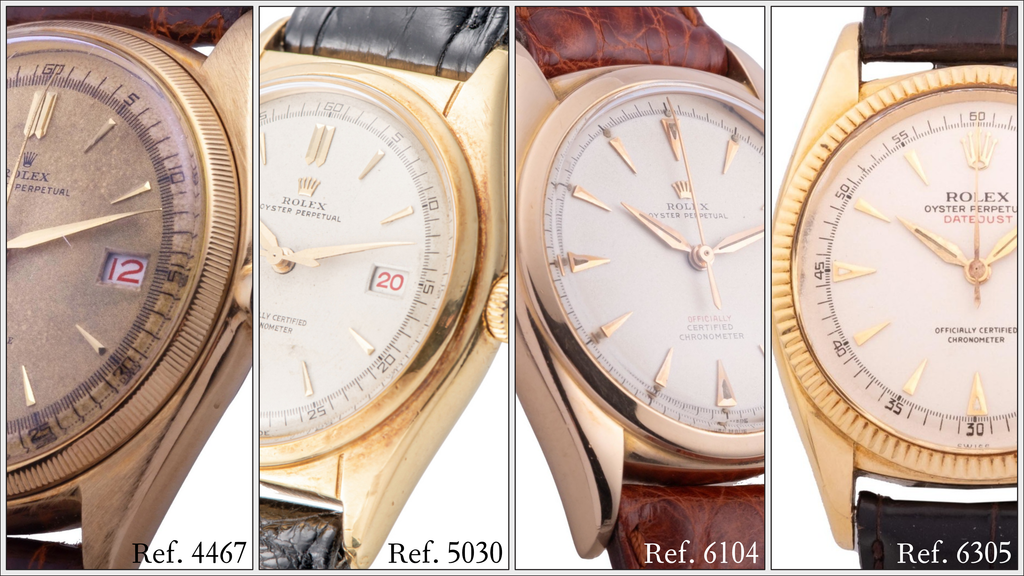 Four examples of early Datejust models featuring the additional lug chamfer. From left to right: Ref. 4467 "Tribune de Geneve", ref. 5030, ref. 6104, ref. 6305. Interestingly, the chamfer and case shape evolves as well throughout the years. Photos Courtesy of Antiquorum.
Four examples of early Datejust models featuring the additional lug chamfer. From left to right: Ref. 4467 "Tribune de Geneve", ref. 5030, ref. 6104, ref. 6305. Interestingly, the chamfer and case shape evolves as well throughout the years. Photos Courtesy of Antiquorum.
Interestingly, already in these early references we can observe an evolution of this additional chamfer in shape and style. The style on the reference 5030 for example is a lot more pronounced than on other models, displaying a very strong chamfer with vertical recesses.
The first Datejust in steel was launched only about 8 years after the original 4467 - the 1953-55 ref. 6305[1]. The moment the steel Datejust was born, its Oyster case was distinct from the precious metal ones... A steel 6305 and a golden 6305 cases are easily distinguishable!
 Comparing two reference 6305 Rolex Datejust executions in steel (bottom, potentially relumed) and gold (top). Do you notice the evident lack of the additional chamfer on the steel model? Photos Courtesy of Antiquorum.
Comparing two reference 6305 Rolex Datejust executions in steel (bottom, potentially relumed) and gold (top). Do you notice the evident lack of the additional chamfer on the steel model? Photos Courtesy of Antiquorum.
2) But the rule is different in 34mm and for Chronographs
So the question emerges: Did you find this on all gold Rolex? As evident and long living as this detail has been for Datejusts... you will find it only on 36mm references with date-complication*... Thus, for example 34mm Oyster Perpetuals (with and w/o Date) did not feature this detail - in ever post 1945*.
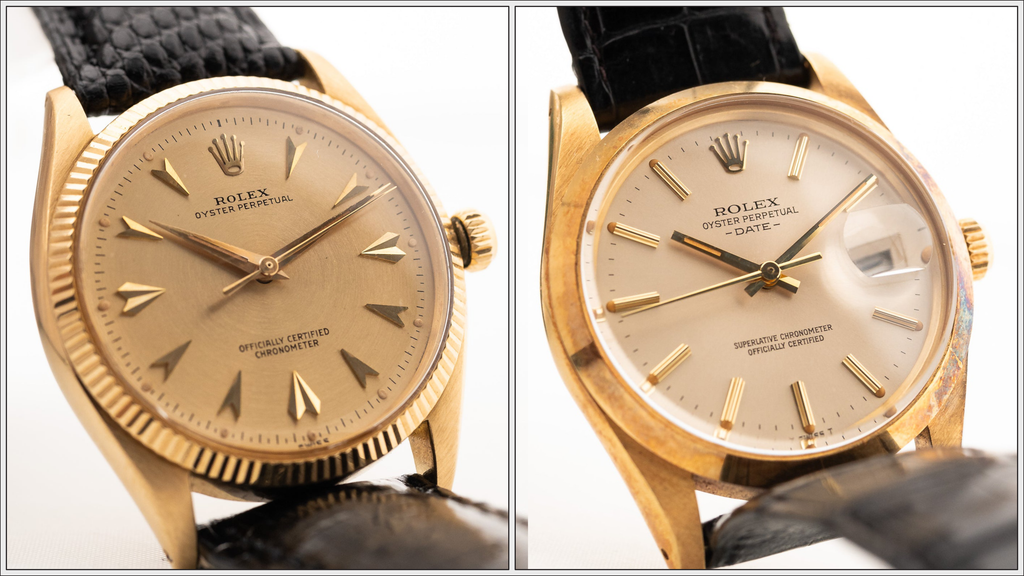 Two vintage 34mm Rolex Oyster Perpetual models - ref. 6567 (left) & ref. 15008 (right) - in gold. From two completely different eras of Rolex watchmaking - 1955 (left) to 1983 (right) - yet both without the extra lug chamfer.
Two vintage 34mm Rolex Oyster Perpetual models - ref. 6567 (left) & ref. 15008 (right) - in gold. From two completely different eras of Rolex watchmaking - 1955 (left) to 1983 (right) - yet both without the extra lug chamfer.
So it didn't exist on smaller models. This is by the way also true for midsize (31mm) & Lady Datejust models. But what about the Daytona (or generally Rolex chronographs)?
The Daytona is another 36mm vintage collection that did come both in solid gold cases as well as steel. Long story short: nothing! Not a single lug chamfer on any of the Daytona models (or chronographs that I'm aware of)** that would dissociate gold from steel.
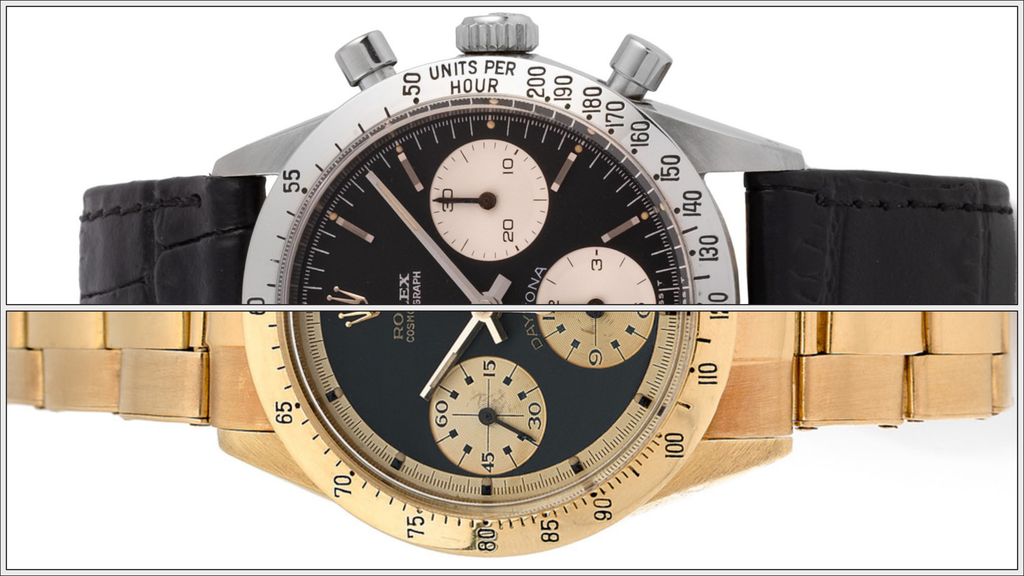 Comparing two vintage Rolex ref. 6239 Daytona Chronograph watches in steel and gold... No sign of a lug chamfer. Photos Courtesy of Antiquorum.
Comparing two vintage Rolex ref. 6239 Daytona Chronograph watches in steel and gold... No sign of a lug chamfer. Photos Courtesy of Antiquorum.
3) But Why?
Of course we can't retrospectively answer the questions "why this feature is common between gold but not steel pieces?" and "why do we find it on Datejust/Day-Date models but not OPs or Daytonas?" But maybe there is some rationale to this 'madness'?
Option A - Structural Integrity (No!):
The first potential rationale comes from a material science perspective. Maybe because gold is such a soft material that lugs might bend if not supported properly? Hence, the extra chamfer. This could explain why you wouldn't see it on steel and potentially smaller models... But the Daytona is also 36mm and the argument crumbles right here already...
Option B - Case Maker (Probably No):
During the last Century cases were still mostly manufactured by third-party case makers and not "in-house" at Rolex. For the Oyster-case models these were predominantly Genex (hallmark Geneva key #12; a Rolex owned company) and Spillmann SA (La Chaux-de-Fonds, #136). Datejust and Day-Date cases were mostly made by Genex, Daytona cases by Spillmann:
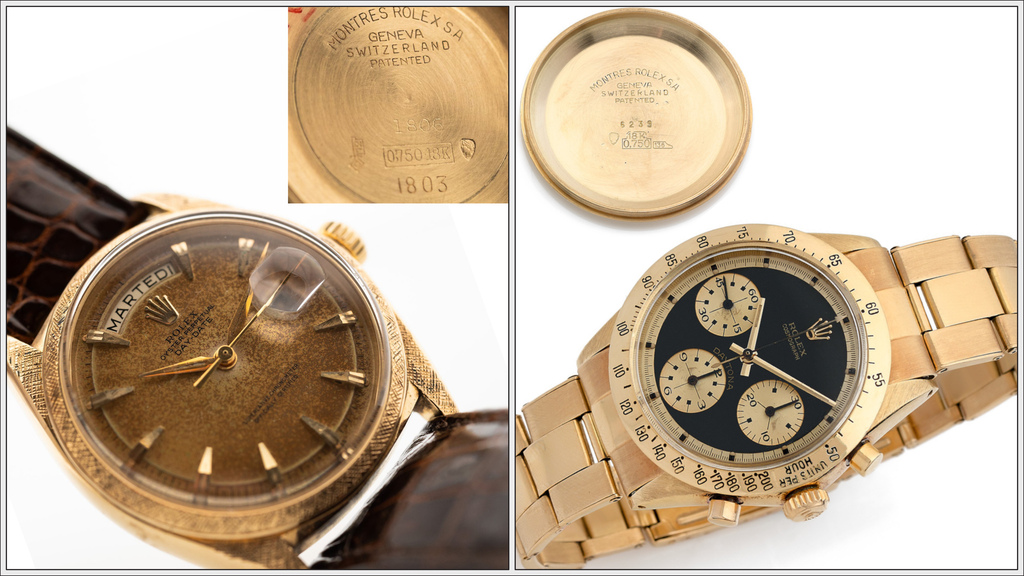 Two golden Rolex Icons - the Day-Date 1806 (left) and Daytona 6239 (right) - with cases made by Genex (key #12, left) and Spillmann (hammerhead #136, right). Photos Courtesy of Goldammer Archives & Antiquorum.
Two golden Rolex Icons - the Day-Date 1806 (left) and Daytona 6239 (right) - with cases made by Genex (key #12, left) and Spillmann (hammerhead #136, right). Photos Courtesy of Goldammer Archives & Antiquorum.
However, Oyster Perpetual cases were also manufactured at Genex (see [here] & [here])... so we're back at square one.
Option C - Tradition & Visual Disambiguation (Maybe?):
However, there is one explanation that does make some sense but it's hard to prove. Just answer me one question: "How do you tell a gold and a steel watch apart?" ... By color, duh!!! But if it's not in front of you, if it's printed, in an advertorial... You see where I'm going?
It wasn't really common until the 1960s or 70s that newspaper and magazine advertorials were colored. So from a picture alone you wouldn't be able to tell which Rolex is steel and which one is golden... That's a problem for a brand that had quite a bit of both in the catalogue.
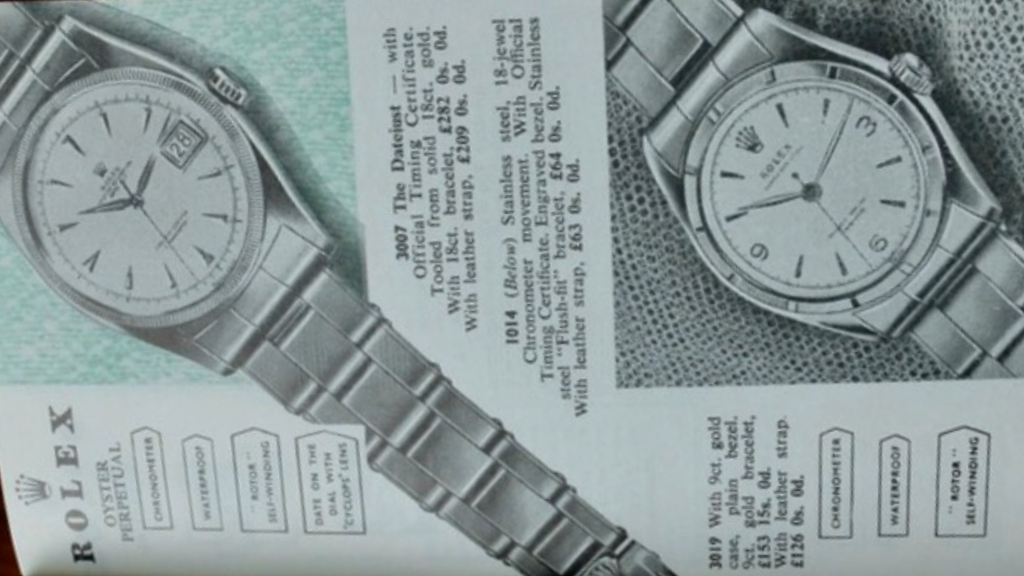 vintage 1950s Rolex catalogue and advertorial - You can easily identify which of the two is steel and which one is gold. Photo Courtesy of Le Monde Edmond.
vintage 1950s Rolex catalogue and advertorial - You can easily identify which of the two is steel and which one is gold. Photo Courtesy of Le Monde Edmond.
Having a certain lug/case style for gold watches makes it easier for the customer (and even the sales rep at the boutique only having the catalogue) to identify their desired case material out of a bunch of depicted pieces. If we dig a little deeper we can even see that the same distinction also holds for earlier Bubblbacks (post-1945) without date (compare for example [here]).
Of course at some point advertorials were predominantly colored but why change then? The tradition is already set up so you gotta roll with it. Nevertheless, it's still very hard to actually prove such a theory without first-hand evidence (internal documentation etc.) and it still doesn't fully explain away the 34mm OPs (Datejusts may have been treated as "special" but it gets muddy here)...
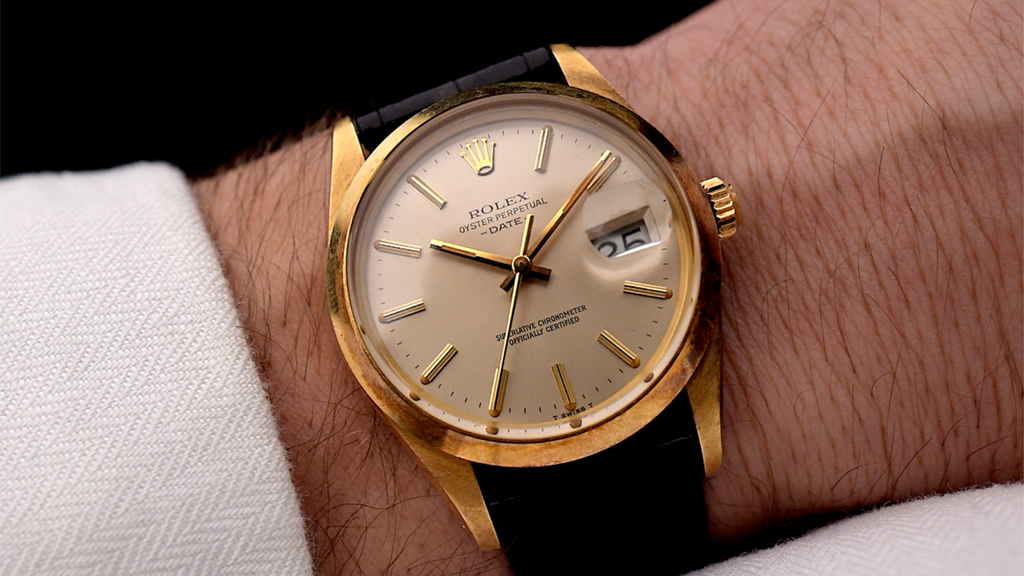 It would be such an intuitive explanation if it wasn't for the break of the rule in the 34mm OPs. Photo Courtesy of Goldammer.
It would be such an intuitive explanation if it wasn't for the break of the rule in the 34mm OPs. Photo Courtesy of Goldammer.
4) Conclusion
What we know is that Rolex did use a special type of case construction for gold Datejust and Day-Date models up until very recently. We further know for certain that this feature has been very consistently used for certain collections but not others between 1945 and 2009. What we can speculate is that this little extra chamfer was meant to aid identification of gold versus steel models in the Rolex catalogue at times of predominant black and white printing but we really don't know for sure...
Well, we also know that I found the topic interesting enough to fan it out over a couple hundred words and you were disciplined enough to ultimately read all of this... It proves to show that collecting vintage Rolex is fascinating for the little details, the extra mile of research you'd have to take with every new aspect you'll inevitably find. Turn another stone - or case - and a completely new mystery unfolds.
If anyone actually knows what this is all about: please let me know! By the way also if all of this is just Rolex pulling another Rolex... it wouldn't surprise at all.
+ I'll try to clarify: A chamfer is a "rounded" extra surface on a watch case. This is in contrast to a "bevel" that is a flat angled surface. In theory the extra surface on some of the references might be better described as a "bevel" but for simplicity we stick with "chamfer" throughout the text.
* However, other earlier Bubbleback Oyster Perpetual (without Date) did feature similar lug chamfers (for example [here]) - however, at times also in steel.
** There are some very fascinating differences between steel and gold Daytona cases but that I'll leave for another time.
References
[1] Datejust: A closer look at a Rolex Icon Part 1; Edmond Saran, Le Monde Edmond [Link]
All rights on text and graphics reserved to the Author.




























Leave a comment